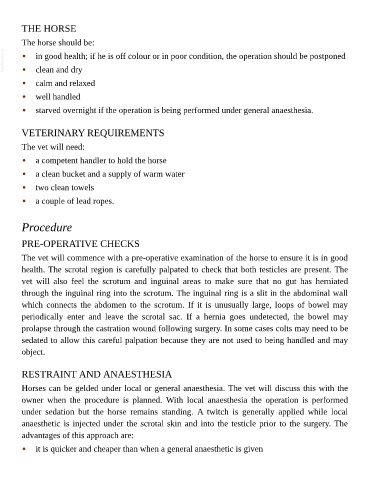Page 908 - The Veterinary Care of the Horse
P. 908
THE HORSE
The horse should be:
VetBooks.ir • in good health; if he is off colour or in poor condition, the operation should be postponed
•
clean and dry
• calm and relaxed
• well handled
• starved overnight if the operation is being performed under general anaesthesia.
VETERINARY REQUIREMENTS
The vet will need:
• a competent handler to hold the horse
• a clean bucket and a supply of warm water
• two clean towels
• a couple of lead ropes.
Procedure
PRE-OPERATIVE CHECKS
The vet will commence with a pre-operative examination of the horse to ensure it is in good
health. The scrotal region is carefully palpated to check that both testicles are present. The
vet will also feel the scrotum and inguinal areas to make sure that no gut has herniated
through the inguinal ring into the scrotum. The inguinal ring is a slit in the abdominal wall
which connects the abdomen to the scrotum. If it is unusually large, loops of bowel may
periodically enter and leave the scrotal sac. If a hernia goes undetected, the bowel may
prolapse through the castration wound following surgery. In some cases colts may need to be
sedated to allow this careful palpation because they are not used to being handled and may
object.
RESTRAINT AND ANAESTHESIA
Horses can be gelded under local or general anaesthesia. The vet will discuss this with the
owner when the procedure is planned. With local anaesthesia the operation is performed
under sedation but the horse remains standing. A twitch is generally applied while local
anaesthetic is injected under the scrotal skin and into the testicle prior to the surgery. The
advantages of this approach are:
• it is quicker and cheaper than when a general anaesthetic is given

